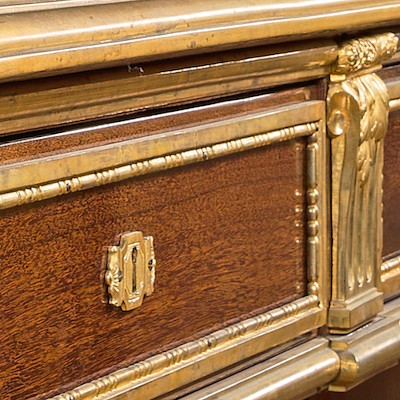[TURGOT (Plan of)]. - BRETEZ (Louis).
Lot 20
Categories
Estimate:
EUR€1,500 - EUR€2,000
$1,612.90 - $2,150.54
Absentee vs Live bid
Two ways to bid:
- Leave a max absentee bid and the platform will bid on your behalf up to your maximum bid during the live auction.
- Bid live during the auction and your bids will be submitted real-time to the auctioneer.
Bid Increments
| Price | Bid Increment |
|---|---|
| No bidding increment | |
About Auction
Catalog Only
By Beaussant Lefèvre & Associés
Dec 13, 2022
Set Reminder
2022-12-13 08:00:00
2022-12-13 08:00:00
America/New_York
Bidsquare
Bidsquare : Furniture and Works of Art from the Anne Aymone and Valery Giscard d’Estaing Collections
https://www.bidsquare.com/auctions/beaussant-lef-vre-associ-s/furniture-and-works-of-art-from-the-anne-aymone-and-valery-giscard-d-estaing-collections-11505
Beaussant Lefèvre & Associés contact@beaussantlefevre.com
Beaussant Lefèvre & Associés contact@beaussantlefevre.com
- Lot Description
[TURGOT (Plan of)]. - BRETEZ (Louis). Plan of Paris. S.l.n.n., 1739-[between 1740 and 1743]. large folio, marbled calf, spine ribbed, cloisonné and fleurdelisé with garnet title-piece, gilt fleurdelisé frieze framing the boards with gilt fleur-de-lis in the spandrels and gilt coat of arms in the center; binding worn with missing leather on the spine, several leaves affected by stains and small angular tears (period binding).
FIRST EDITION.
21 engraved plates mounted on tabs, that is to say: a folding assembly plan and 20 double-page plates, 2 of which are folded into a folding panel.
THE MOST BEAUTIFUL IMAGE OF OLDER PARIS, "AU NATUREL": the city is represented in forced perspective so that all the buildings remain visible at a constant scale. This is the last plan of this kind for Paris.
A LONG-TERM CARTOGRAPHIC PROJECT, launched in January 1734 by the city of Paris. The order was placed not with an engineer or a topographer, but with a draftsman, Louis Bretez, professor of perspective and member of the Academy of painting of Saint-Luc, author in 1706 of the treaty The practical perspective of architecture. The aim was to establish a plan intended to "satisfy the curiosity of the king's subjects and foreigners", and for that purpose to make it "easy to recognize particularly the public buildings and monuments and even those which, although for the use of several citizens, will recall to posterity the memory of the most excellent masters in architecture". Louis Bretez, who obtained free entry everywhere in Paris, undertook to hand over a hand-drawn and washed plan on colored vellum representing all the buildings at least 2 meters high by 3 wide. In March 1736, he had completed his master drawing, but his collaborator Saury, who was in charge of the line drawing in Indian ink and the color wash, had died without having finished his work. Louis Bretez had to continue alone but died himself in 1738.
This did not prevent the city from hiring two engravers in 1736, Antoine Coquart and Claude Lucas, who each bore the title of "engraver of the Academy of Sciences". Antoine Coquart retired in 1738, handing over the six plates he had produced to Claude Lucas, who completed the engraving in December 1739. The Parisian intaglio printer Pierre Thévenard, hired in December 1738, proceeded to print the plates during the year 1739, for about 2450 copies. Louis Bretez brought in addition, out of contract, an assembly plan in reduction, which Pierre Thévenard printed in April 1740.
BINDING OF ORDER BY ANTOINE-MICHEL PASDELOUP. The work was then entrusted by the city to the workshop of this bookbinder who, from 1739 to 1743, produced five types of copies: about 1050 of them in rolls mounted on gorges (of three different kinds), and about 1400 copies in lace bindings (of which at least 600 copies in calfskin and at least 630 in morocco), most of them with the arms of Paris.
A THEATER MONUMENT TO THE GLORY OF THE CAPITAL AND ITS MARKET PRÉVÔT TURGOT.
In office from 1729 to 1740, Michel-Étienne Turgot pursued an active policy to promote the image of Paris, commissioning the publication of three prestigious works: a book of celebrations to mark the 1739 marriage of Louis XV's eldest daughter to the second son of the King of Spain, a scientific geometrical plan of Paris commissioned in 1735 from the Abbé Jean Delagrive (published in 1741), and above all the present plan "au naturel": published from April 1740, it was widely distributed to the main French institutions in Paris and in the provinces, but also to most of the European Courts - and probably even to Constantinople and China. This "Turgot plan" "thus constitutes a veritable promotional and propaganda operation, to the glory of the city as the capital of the kingdom and of the provost of the merchants who has just increased both its extent and its brilliance" (in Jean Boutier, ed., Les Plans de Paris des origines - 1493 - à la fin du xViiie siècle, Paris, BnF, 2002, n° 219).
EXAMPLE WITH THE ARMS OF THE CITY OF PARIS (OHR, pl. n° 2121, iron n° 3).
Provenance: Jean Bardoux (bookplate).



 EUR
EUR CAD
CAD AUD
AUD GBP
GBP MXN
MXN HKD
HKD CNY
CNY MYR
MYR SEK
SEK SGD
SGD CHF
CHF THB
THB![[TURGOT (Plan of)]. - BRETEZ (Louis).](https://s1.img.bidsquare.com/item/l/1919/19193188.jpeg?t=1P2DKI)
![[TURGOT (Plan of)]. - BRETEZ (Louis).](https://s1.img.bidsquare.com/item/s/1919/19193188.jpeg?t=1P2DKI)










